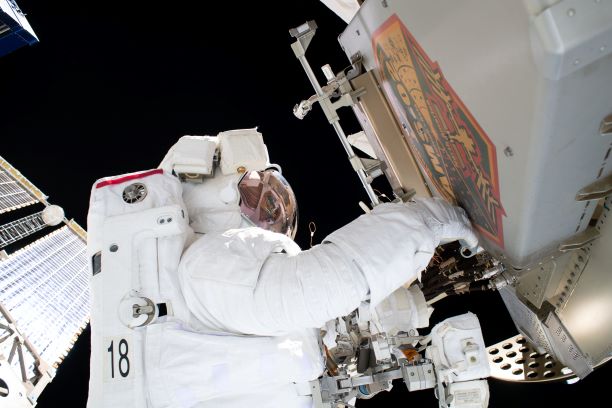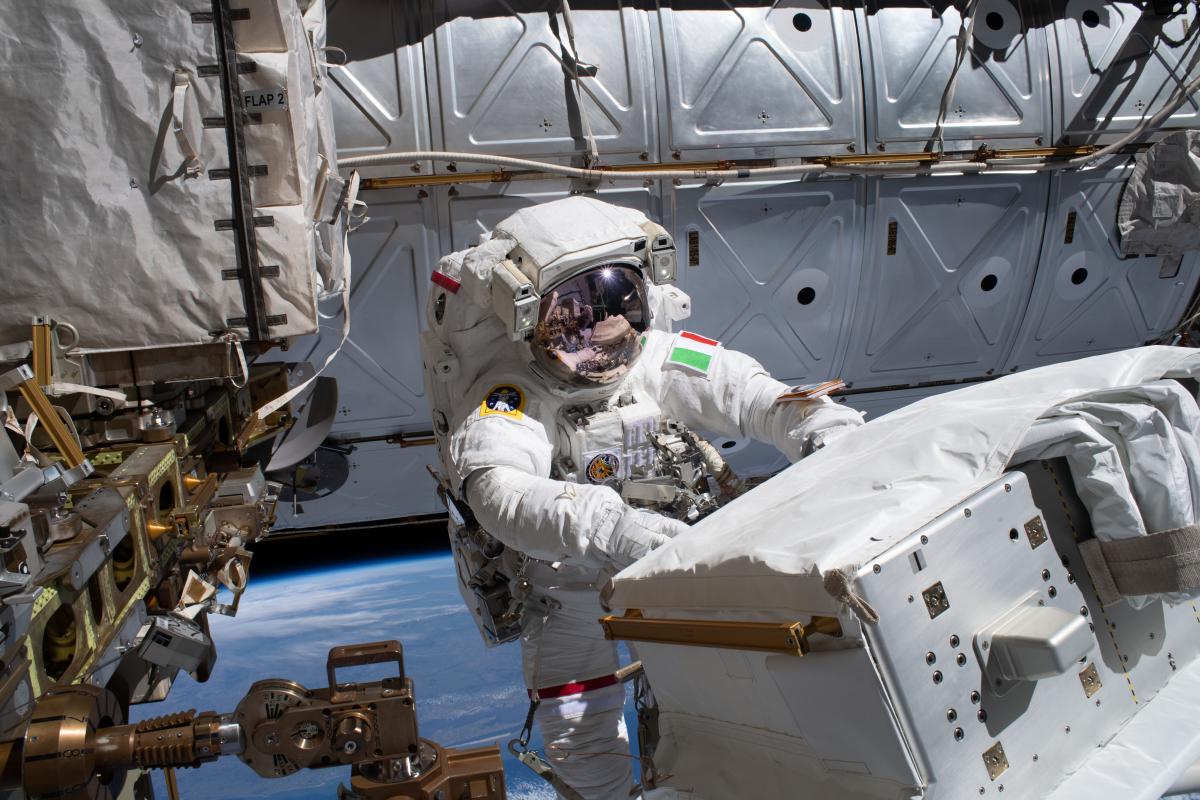AMS-02 cooling pumps replaced during series of spacewalks
The AMS-02 experiment was designed and developed by an international team led by MIT physicist Samuel Ting and assembled at CERN starting in 2003. Perched atop the International Space Station’s S3 truss segment, AMS-02 has been hunting for cosmic particles that have traveled from the furthest reaches of the universe. It was originally meant to run for three years without the need for any intervention by the inhabitants of the ISS.
 The detector consists of a series of components that record the identity, trajectory and momentum of subatomic particles zipping around the cosmos. Just as visible light allows astronomers to study distant stars and galaxies, these particles—cosmic rays—enable physicists to study the far reaches of the universe. AMS-02 also allows physicists to search for evidence of dark matter, an elusive material that has so far been observed only through its gravitational pull on visible matter.
The detector consists of a series of components that record the identity, trajectory and momentum of subatomic particles zipping around the cosmos. Just as visible light allows astronomers to study distant stars and galaxies, these particles—cosmic rays—enable physicists to study the far reaches of the universe. AMS-02 also allows physicists to search for evidence of dark matter, an elusive material that has so far been observed only through its gravitational pull on visible matter.
The AMS-02 experiment was launched to the ISS aboard the Space Shuttle Endeavour’s STS-134 mission in May 2011.The experiment was originally designed to run through 2014 and has already survived more than twice that long. During this lifetime, it has collected data from more than 148 billion cosmic rays. The observation of anti-nuclei heavier than antiprotons in cosmic rays would have far-reaching consequences as they might originate from either segregated primordial antimatter or from the annihilation of dark matter particles. Thus, the search for these particles addresses two of the most fundamental questions in modern physics: the baryon to anti-baryon asymmetry in the universe as well as the existence and nature of dark matter, which is assumed to account for about 85% of the matter in the universe and for about a quarter of its total energy density.
While the rest of the detector is still in excellent shape, the pumps for the internal cooling system of the tracking detector have not been functioning properly which motivated the need for an upgrade. Specifically, three of the instrument’s four cooling pumps have failed, they were never meant to be repaired or replaced, which should mean that the AMS-02 would soon be switched off, and retire from its marathon particle-hunting mission. However, the scientific community profiting and learning so much from AMS-02 data was not ready for that.
Therefore, they start planning a repair over the course of several spacewalks. This would allow AMS-02 to continue collecting data through 2030 and continue searching for new physics in a complementary fashion with data from underground and collider experiments. Over four years the AMS-02 team worked at the development and construction of a new pump system to replace the existing one, while the team of astronauts trained at NASA’s Johnson Space Center to perform four spacewalks, each lasting more than six hours. Their training involved a variety of ways to simulate repairs including a large swimming pool called the Neutral Buoyancy Lab (NBL), a suspension harness called the Active Response Gravity Offload System (ARGOS), and virtual reality applications.
Because the AMS-02 detector was not designed to be repaired in space, the CERN-AMS project engineer, Corrado Gargiulo of the EP department, and the NASA team in charge of the operations had to identify the best location for the intervention and carefully design a process that would allow to remove a bulky debris shield, and cut through the stainless-steel cooling pipes without creating safety risks for the crew of the ISS. Treating with objects that have sharp edges in space and having to work around such an area is very challenging. Part of the solution was to develop a set of roughly 25 specialized space tools to be used and stored in the ISS. This mission is considered to be one of the most challenging spacewalks since work to repair the Hubble Space Telescope.
Finally last month, on November 15th, Luca Parmitano, the Italian astronaut from ESA, and his spacewalking partner, NASA astronaut Andrew Morgan, went for their first Extra Vehicular Activity, EVA1. Jessica Meir and Christina Koch, NASA astronauts, supported the duo from inside the Station. They operated the Canadarm2 robotic arm, with Luca fixed at its extremity through his spacesuit boots; they positioned and kept Luca at the exact AMS-02 work sites, on top of the Station's S3 Truss structure, between a pair of solar arrays and radiators. Andrew arrived in the proximity of Luca moving along the ISS Truss, and secured to different ISS handrails. The two astronauts managed to remove the debris shield, necessary to gain access to the main work site (Fig1). Given the size of the shield, the best option was to jettison it, something rarely done - as they couldn’t take it back inside the ISS.

Figure 1: Preparing to remove the AMS-02 detector debris shield and gain access to the main working site.
After EVA1, on November 22nd at around 13:05 CET, Luca and Drew went out again, for the second EVA. The depressurization of the AMS cooling system and the following cuts of the eight stainless steel lines were accomplished through an exceptional successful sequence of operations. The old cooling box with the failed pumps was, in this way, isolated and the cut lines ready for the connection to the new pump system.

Figure 2. During a spacewalk earlier this month, Luca Parmitano carried out of the ISS the box with the new pumps to be installed in AMS-02 (Credit: NASA).
On the 2nd of December, Luca carried out the large box with the new pumps (Fig 2) and, with Drew, started the most critical spacewalk, EVA3. The new box was fixed to AMS-02, then the power and data connectors were mated such to allow CERN-AMS Payload Operations Control Center team to establish the communication and control. Luca and Andrew spent the next hours connecting one after the other the eight tubes to the new pumps, through specifically designed hydraulic connectors.
Figure 3. The long process to swage (connect) the tubes is completed using a specially designed 7/8” wrench. (via @Luca Parmitano Twitter account, Credit: NASA).
Such a repair in outer space, that would have been a complex intervention on ground, has been a unique and extraordinary challenge. The difficulties have been overcome by the astronauts’ skills supported in real time by experts from the Mission Control Center in Houston, including Corrado, after extensive training and planning on the ground based on the through documentation collected while assembling AMS-02 at CERN. Luca and Drew refer to the diagrams prepared by Corrado as “pure magic”.
A final spacewalk is planned in January to check for leaks, and arrange thermal insulation to replace the jettisoned debris shield.
Many challenges have been tackled leading up to and during these spacewalks. When the upcoming EVA is successfully completed, it will allow AMS-02 to continue to hunt for particles to deepen, challenge and potentially change the understanding of our universe for years to come.
The author would like to thank Mike Capell and Corrado Gargiulo for their fruitful comments and suggestions.
Note: The first photo in the article shows a spectacular view from above, through @AstroDrewMorgan ’s lens while flying over the Caribbean (Credit: NASA)

